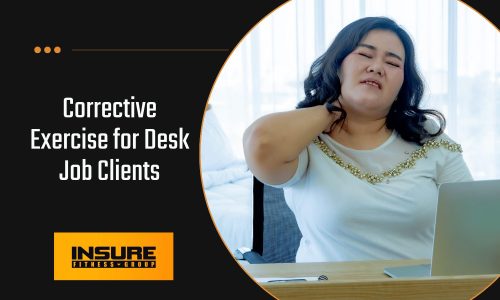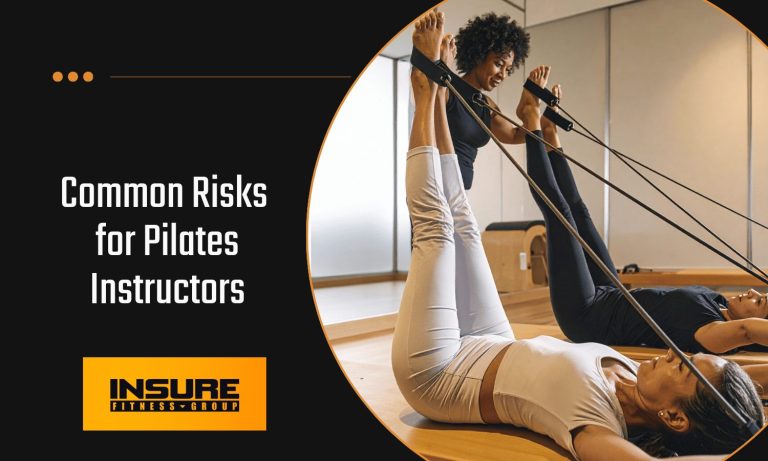Head, shoulders, back, and toes. While this may sound like I sang the incorrect lyrics to a children’s song, it could just as well be a list of everything that hurts before your clients even reach their lunch break. We often associate bodily pain and muscle tension with highly physical jobs – think construction, agriculture, and forestry. Far less often do we think about the toll desk jobs take on our clients’ bodies.
Many office workers struggle with aches, pains, fatigue, and postural imbalances as a result of prolonged sitting and sedentary behavior. Long hours in a chair, even if they have a state-of-the-art ergonomic chair, are hard on the body. Those who spend the majority of their workday sitting also have higher mortality rates and increased cardiovascular risk.

Let’s face it, even if they have a fancy chair, it still doesn’t mean they’re sitting in it correctly. Most of us, myself included, wind up sitting on our feet, crossing our legs, or rounding our backs when we sit in a chair, and no amount of chair can fix us if we don’t bother to sit up.
As a result, our clients have poor posture, rounded shoulders, and forward head posture, not to mention muscle imbalances and musculoskeletal issues like upper crossed syndrome. And all from just sitting there!
The upside to their sad song is that many of these aches and pains can be remedied with simple corrective exercises and short movement breaks. They can reduce the harmful effects of sitting while improving strength, posture, and overall health. The body is built to move, so fitness professionals should encourage less sitting and more activity.
What are the key postural imbalances in desk workers that corrective exercise should target?
While everyone sits differently, there are common postural imbalances that affect the majority of office workers. When assessing imbalances, we start from the bottom and work up.
Prolonged sitting can create imbalances in the hips and lower back. Ideally, someone would be seated in a chair where both feet are flat on the floor, with appropriate support for the hips and low back. When this doesn’t happen, or when someone sits off-center, they can develop lower crossed syndrome. The hip flexors and low back begin to tighten, while the abdominals and glutes become overstretched. This can cause an anterior pelvic tilt, poor hip mobility, and pain in the lower back. To correct lower crossed syndrome, begin with simple exercises that strengthen the abdominals and glutes and stretches that target the lower back and hip flexors. Foam rolling and mobility drills are your friends for both lower and upper body work and complement strengthening and stretching programs.

Desk jobs can have an even bigger impact on the upper body, and muscle imbalances abound. When working at a computer, the arms reach forward and can tighten the pectoralis major and traps, while weakening and overstretching the upper back. This postural imbalance is known as upper crossed syndrome. It rounds the shoulders forward, creating tension in the shoulders, back, and neck, often creating chronic pain.
As a trainer, this is one of the most common conditions I treat. For clients in the early stages of upper crossed syndrome or with mild symptoms and impairment, it can be remedied much like lower crossed syndrome. Focus on strengthening the upper and middle back and the neck while lengthening and stretching the chest and shoulders. If your client is fighting severe symptoms or imbalance, you may want to refer them to a physical therapist for more in-depth and hands-on treatment.
With both upper and lower crossed syndrome and any other muscular imbalance, you can stretch and strengthen all you want, but if your client wants lasting change, their desk setup may need to change. It is often said that nothing changes if nothing changes, and that applies here. We have to dig into the roots of the problem – poor conditions coupled with weak or tight muscles. Encourage your clients to create a workspace that supports their health, rather than degrading it.

Pro Tip: I love to provide clients with a handout that teaches simple ways to modify their workspace for better posture. I include simple fixes like sticking a book or box under the computer monitor to reduce forward head lean and as well as big-ticket suggestions like selecting an office chair that combats their specific muscle imbalances. Include lots of pictures for maximum effect!
Once you break down the major challenges of working at a desk and program for it, you can add in elements to tackle smaller areas, specifically the forearms, wrists, and hands. Unless you’re a rock climber or that one guy at the gym who wants to have massively large forearms for no plausible reason, you probably don’t pay much attention to these fine muscles and joints.
Relentless typing and mouse use can cause repetitive strain injuries such as carpal tunnel and tendinitis. These injuries can get tricky because they don’t always resolve with simple stretching. Changes in their workspace are key, as are corrective exercises. Left untreated, these overuse injuries may be exacerbated to the point where surgery is needed. Rather than letting your clients get that far, start with postural and strengthening exercises now, before symptoms arise.
Which corrective and strengthening exercises can break the cycle of prolonged sitting?
Corrective exercises can be added with ease to nearly any exercise program. For maximum impact, use them in your sessions together and encourage your clients to incorporate them into their workday.
Corrective exercises can be included in any portion of a client’s workout. Exercises that include dynamic stretching or movements are beneficial in the warm-up. Examples of these include:
- High knees, gate opens and closes for the hips, or arm swings can engage and warm major muscle groups. They also increase heart rate and energy levels.
- Try it: 30-60 second bursts of activity. Repeat 2-5 times.
- Short bursts of cardio like jogging in place, a walk around the building, or climbing a flight of stairs can get muscles moving and interrupt long periods of sitting.. Anyone want to meet for jumping jacks in the parking lot?
- Try it: 15-60 seconds with an equivalent (or less) rest in between sets. Repeat 2-5 times.
- Hip hinge exercises like good mornings can provide a great stretch while strengthening.
- Try It: 3 sets of 8-10 reps, increasing reps as mobility and strength improve.

If you’re chatting with a client in between sets during the main body of your workout, sprinkle in postural exercises for an extra boost:
- Chin tucks or cervical retraction strengthen muscles along the back of the neck and improve day-to-day posture. Plus, who doesn’t want to practice their double chin in front of the gym mirrors? (Maybe consider a more private location for this one).
- Try it: 2 sets of 15 reps (we’re not looking to bulk here)!
- Unweighted or lightweight scapular retractions are an easy exercise for clients to replicate at their desks. Wall angels are another great option to engage the shoulders and upper back.
- Try it: 2 sets of 10-15 reps
- Chest strengthening exercises like push-ups or flys are effective for building up pectoral strength. Clients can add them to their workday workout by doing desk push-ups or leaning back in their chair for a supported bodyweight fly.
- Try it: 3 sets of 10-15 reps

Static stretching and deep tissue exercises can be included toward the end of a workout or in the cool-down. Close out your session with exercises like:
-
- Isometric holds like plank variations (think side planks or one-leg planks) and hip bridges can help the body transition from the main workout into the cool-down without sacrificing effort. I once had a coworker who enjoyed plank challenges at his desk during breaks. Overachieving? Yes. Likely had better abs than the rest of our team? Also yes.
- Try it: 2-4 sets of 15-second holds.
- Foam rolling for the upper and lower body is an underrated and underused method to dig into deeper tissues where chronic tension is held.
- Try it: 2-5 minutes of rolling per area, focusing on large muscle groups.
- Chest opening stretches like the doorway chest stretch (also achievable via a cubicle wall).
- Try it: 30-60 second holds, repeated 2 times.

While it may be difficult or unnerving for clients to begin practicing corrective exercises at work, continue to encourage them. Identify time blocks throughout their day when such activities could be incorporated without interrupting their workflow. If your client wants to take the next step and do more at the office, check out the article Chair Workouts and Low Mobility Exercises for All for chair exercises and mobility drills for clients of varying ability levels, then design an at-work routine they can complete throughout their day.
How do we implement a safe, effective corrective exercise routine in a desk client’s daily workflow?
Most desk workers aren’t ready or willing to lead an exercise revolution at their workplace, and who can blame them? While they may not be able to change company culture, they can take more control over their own workdays and modify where they have the ability to do so.
When faced with a future of fatigue and pain, clients are more likely to seek out help, and their success is based largely on our ability as fitness professionals to help them identify and correct deficiencies in their current exercise and work routines. Understanding the challenges they face, such as limited downtime, long hours, and competing priorities, can help us better understand what they’re up against.
As you help them implement a safe and effective corrective exercise routine into their workday, introduce three key principles for success:
- Move as often as possible, or at least every 30-60 minutes. Even if it’s just standing up or reaching overhead, all movement is good movement. I also encourage clients to set a timer to change sitting positions and check in with their posture every 15 minutes. A quick check-in can keep hotspots and pain points from flaring up.
- Incorporate regular micro workouts or office mini sessions. Help them identify opportunities for movement. Think Zoom meetings, when they can turn their camera off or phone calls with headphones so they can stand up and do a few stretches. When I worked in an office, my mini sessions were on my way to and from the bathroom. I’d take the long way around, run a quick set of stairs on the way back, or do walking lunges down the hallway on my way. It was a great way for me to get moving and start some interesting conversations with my coworkers.
- Start small and progress from there. Don’t make their exercise routine another arduous task to check off their to-do list. Give them simple activities that feel good so that they want to keep doing them. Slowly build up, either via sets, reps, or intensity.
If you’ve been an office worker yourself or like the idea of making a difference in people’s workday, consider specializing in desk-worker corrective exercise programming, a niche needed worldwide.

Conclusion
About 86% of employed Americans work at a desk, which means that there’s no shortage of clients needing corrective exercise. Desk workers are at an elevated risk for health issues from prolonged sitting and poor posture, but corrective exercise offers a practical route to improved posture, strength, mobility, and overall well-being. Help them start by making small daily changes, encouraging consistency, and crafting desirable and realistic activities to help them keep moving throughout their workday.
With years of working with fitness professionals and employing desk workers themselves, Insure Fitness is a trusted resource for trainers as they craft corrective exercise solutions for office workers. For questions or support in your journey, contact us here.





